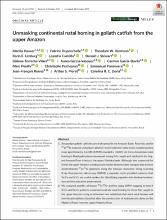Por favor, use este identificador para citar o enlazar este ítem:
https://hdl.handle.net/20.500.12921/415| Título : | Unmasking continental natal homing in goliath catfish from the upper Amazon |
| Autor : | Hauser, Marília Duponchelle, Fabrice Hermann, Theodore W. Limburg, Karin E. Castello, Leandro Stewart, Donald J. García Vásquez, Aurea García Dávila, Carmen Pouilly, Marc Pecheyran, Christophe Ponzevera, Emmanuel Renno, Jean-François Moret, Arthur S. Doria, Carolina R. C. |
| Palabras clave : | Brachyplatystoma rousseauxii Peces de agua dulce Bagre de agua dulce Pimelodidae Especies migratorias Peces migratorios Represas Madeira, río Otolitos Amazonía |
| Fecha de publicación : | dic-2019 |
| Editorial : | Wiley |
| Citación : | Freshwater Biology, 65(0): 1–12 |
| Resumen : | Amazonian goliath catfishes are widespread in the Amazon Basin. Recently, otolith 87Sr:86Sr analyses using laser ablation–multi‐collector–inductively coupled plasma mass spectrometry (LA‐MC‐ICPMS) revealed a >8,000 km trans‐Amazonian natal homing in Brachyplatystoma rousseauxii among fish caught and hatched in the largest Amazon River tributary, the upper Madeira basin. Although also suspected for fish in the upper Amazon, homing could not be demonstrated owing to less distinct environmental 87Sr:86Sr gradients along the Amazon mainstem. Using scanning X‐ray fluorescence microscopy (SXFM), a separate study provided evidence that Se:Ca and Sr:Ca are useful markers for identifying migration into Andean headwaters and the estuarine environment. We analysed otoliths of known 87Sr:86Sr profiles using SXFM mapping to test if Sr:Ca and Se:Ca patterns could demonstrate natal homing for three fish caught in the upper Amazon, using as reference two individuals that were natal homers and two forced residents (hatched after the construction of hydroelectric dams on the Madeira River) from the upper Madeira River. As hypothesised, although the Sr isotope profiles of the upper Amazon individuals were uninformative, two of them presented similar alternating mirror patterns of Sr:Ca and Se:Ca to those of the upper Madeira natal homers, indicating migrations out of the Andean region and into the estuary area. Both were therefore natal homers from the upper Amazon. The third individual from the upper Amazon presented similar Sr:Ca and Se:Ca patterns to those of the upper Madeira residents, suggesting it was a natural resident from the upper Amazon. By combining the results of 87Sr:86Sr analyses (LA‐MC‐ICPMS) and Sr:Ca and Se:Ca mappings (SXFM) that are completely independent of one another, we demonstrated that B. rousseauxii also performs natal homing in the upper Amazon. Our results indicate that the life cycle of B. rousseauxii is more complex than previous literature hypothesised, with the existence of partial migration, even in absence of physical barriers. Quantifying the relative importance of these different life‐history strategies will have important implications for fisheries management. Our results also lay the groundwork for conservation efforts in the context of hydropower development in the Amazon Basin and set testable hypotheses of the potential impacts of the Madeira River dams. |
| URI : | https://hdl.handle.net/20.500.12921/415 https://doi.org/10.1111/fwb.13427 |
| ISSN : | 1365-2427 |
| Aparece en las colecciones: | Artículos en revistas indexadas |
Ficheros en este ítem:
| Fichero | Descripción | Tamaño | Formato | |
|---|---|---|---|---|
| Hauser_articulo_2019.pdf Until 2039-12-01 | Texto Completo | 1,8 MB | Adobe PDF |  Visualizar/Abrir Request a copy |
Compartir :
Los ítems de DSpace están protegidos por copyright, con todos los derechos reservados, a menos que se indique lo contrario.



